Building Information Modelling (BIM) Report: Principles and Roles
VerifiedAdded on 2022/08/26
|8
|1512
|17
Report
AI Summary
This report delves into the core principles of Building Information Modelling (BIM), emphasizing its role in the construction industry. It examines the collaborative nature of BIM, highlighting how it facilitates data exchange and management throughout a project's lifecycle. The report outlines key principles, including processes, policies, people, information, and technology, and their significance in effective BIM implementation. It then explores BIM technology and software, detailing how these tools enable collaboration among engineers, designers, project managers, and contractors. The report also defines the roles and responsibilities of a BIM manager, who oversees BIM processes, ensuring they support project goals from design to handover. The report emphasizes the importance of BIM in improving project outcomes through enhanced information flow and control.
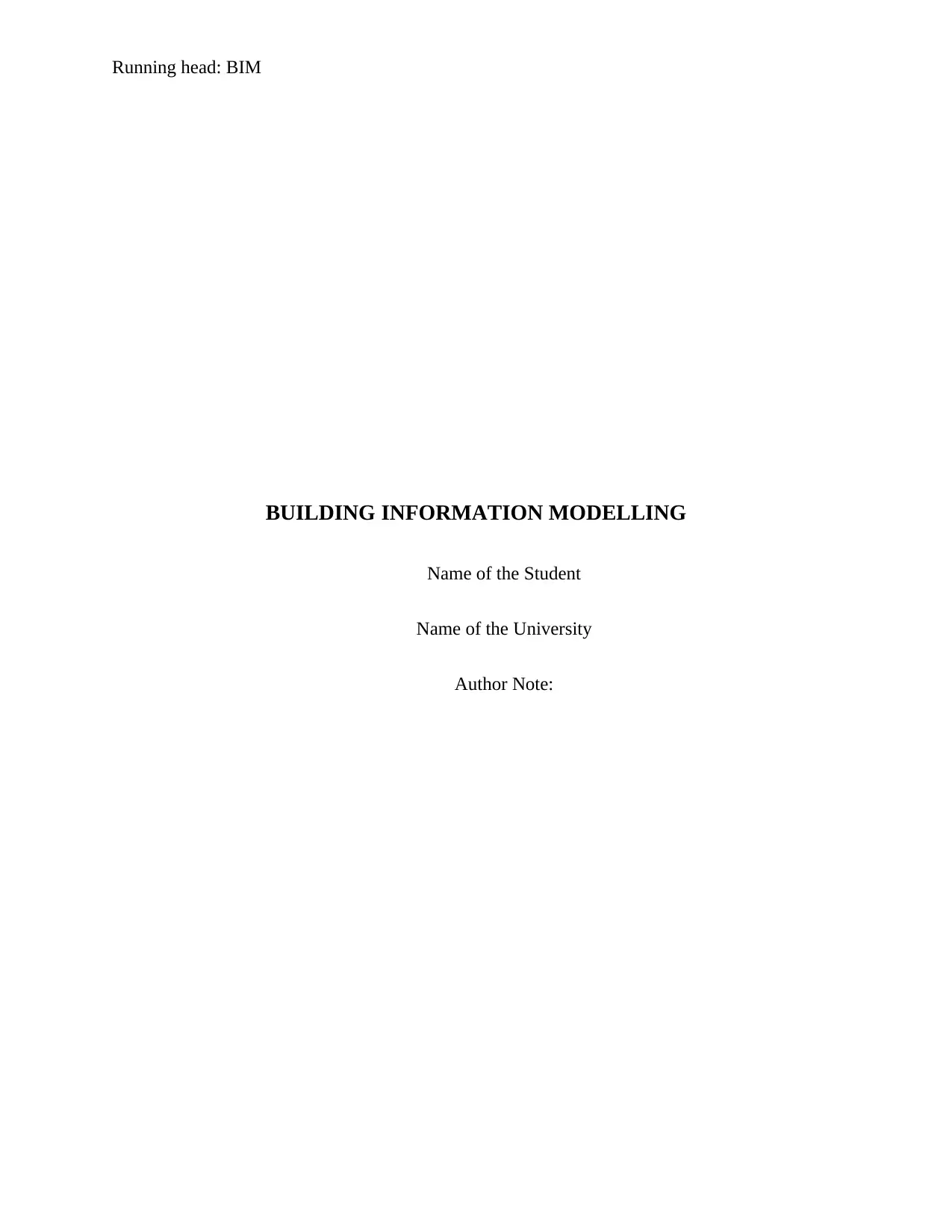
Running head: BIM
BUILDING INFORMATION MODELLING
Name of the Student
Name of the University
Author Note:
BUILDING INFORMATION MODELLING
Name of the Student
Name of the University
Author Note:
Paraphrase This Document
Need a fresh take? Get an instant paraphrase of this document with our AI Paraphraser
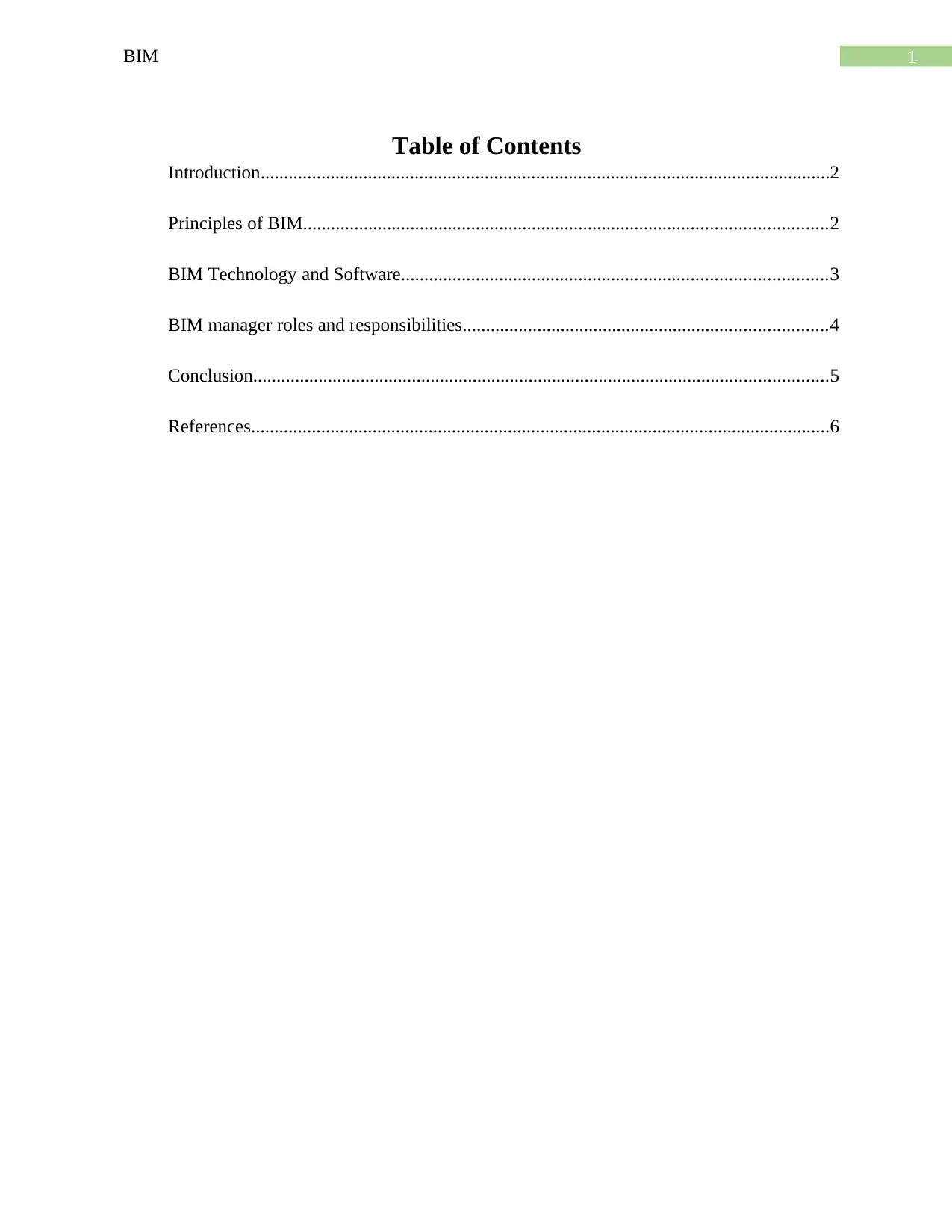
1BIM
Table of Contents
Introduction..........................................................................................................................2
Principles of BIM................................................................................................................2
BIM Technology and Software...........................................................................................3
BIM manager roles and responsibilities..............................................................................4
Conclusion...........................................................................................................................5
References............................................................................................................................6
Table of Contents
Introduction..........................................................................................................................2
Principles of BIM................................................................................................................2
BIM Technology and Software...........................................................................................3
BIM manager roles and responsibilities..............................................................................4
Conclusion...........................................................................................................................5
References............................................................................................................................6
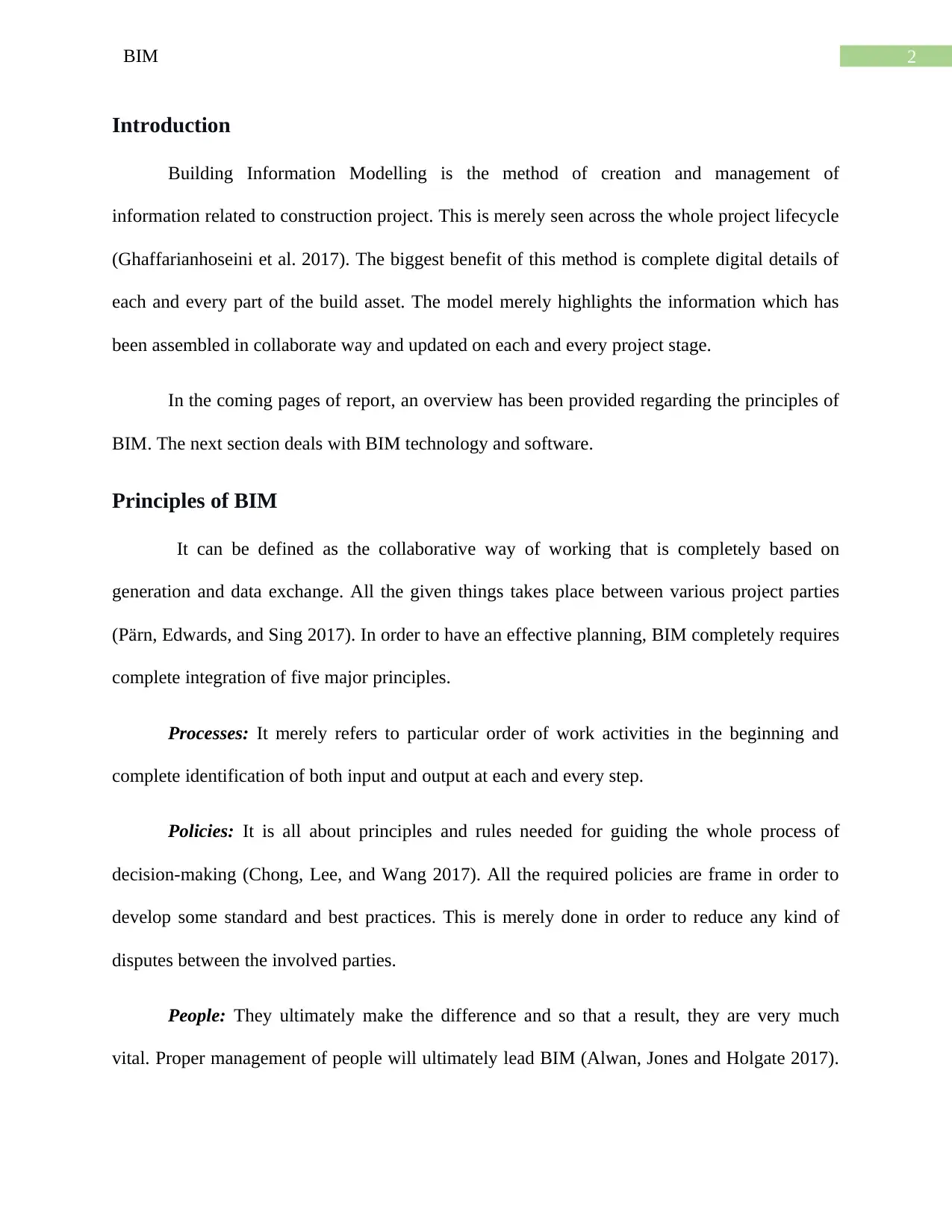
2BIM
Introduction
Building Information Modelling is the method of creation and management of
information related to construction project. This is merely seen across the whole project lifecycle
(Ghaffarianhoseini et al. 2017). The biggest benefit of this method is complete digital details of
each and every part of the build asset. The model merely highlights the information which has
been assembled in collaborate way and updated on each and every project stage.
In the coming pages of report, an overview has been provided regarding the principles of
BIM. The next section deals with BIM technology and software.
Principles of BIM
It can be defined as the collaborative way of working that is completely based on
generation and data exchange. All the given things takes place between various project parties
(Pärn, Edwards, and Sing 2017). In order to have an effective planning, BIM completely requires
complete integration of five major principles.
Processes: It merely refers to particular order of work activities in the beginning and
complete identification of both input and output at each and every step.
Policies: It is all about principles and rules needed for guiding the whole process of
decision-making (Chong, Lee, and Wang 2017). All the required policies are frame in order to
develop some standard and best practices. This is merely done in order to reduce any kind of
disputes between the involved parties.
People: They ultimately make the difference and so that a result, they are very much
vital. Proper management of people will ultimately lead BIM (Alwan, Jones and Holgate 2017).
Introduction
Building Information Modelling is the method of creation and management of
information related to construction project. This is merely seen across the whole project lifecycle
(Ghaffarianhoseini et al. 2017). The biggest benefit of this method is complete digital details of
each and every part of the build asset. The model merely highlights the information which has
been assembled in collaborate way and updated on each and every project stage.
In the coming pages of report, an overview has been provided regarding the principles of
BIM. The next section deals with BIM technology and software.
Principles of BIM
It can be defined as the collaborative way of working that is completely based on
generation and data exchange. All the given things takes place between various project parties
(Pärn, Edwards, and Sing 2017). In order to have an effective planning, BIM completely requires
complete integration of five major principles.
Processes: It merely refers to particular order of work activities in the beginning and
complete identification of both input and output at each and every step.
Policies: It is all about principles and rules needed for guiding the whole process of
decision-making (Chong, Lee, and Wang 2017). All the required policies are frame in order to
develop some standard and best practices. This is merely done in order to reduce any kind of
disputes between the involved parties.
People: They ultimately make the difference and so that a result, they are very much
vital. Proper management of people will ultimately lead BIM (Alwan, Jones and Holgate 2017).
⊘ This is a preview!⊘
Do you want full access?
Subscribe today to unlock all pages.

Trusted by 1+ million students worldwide
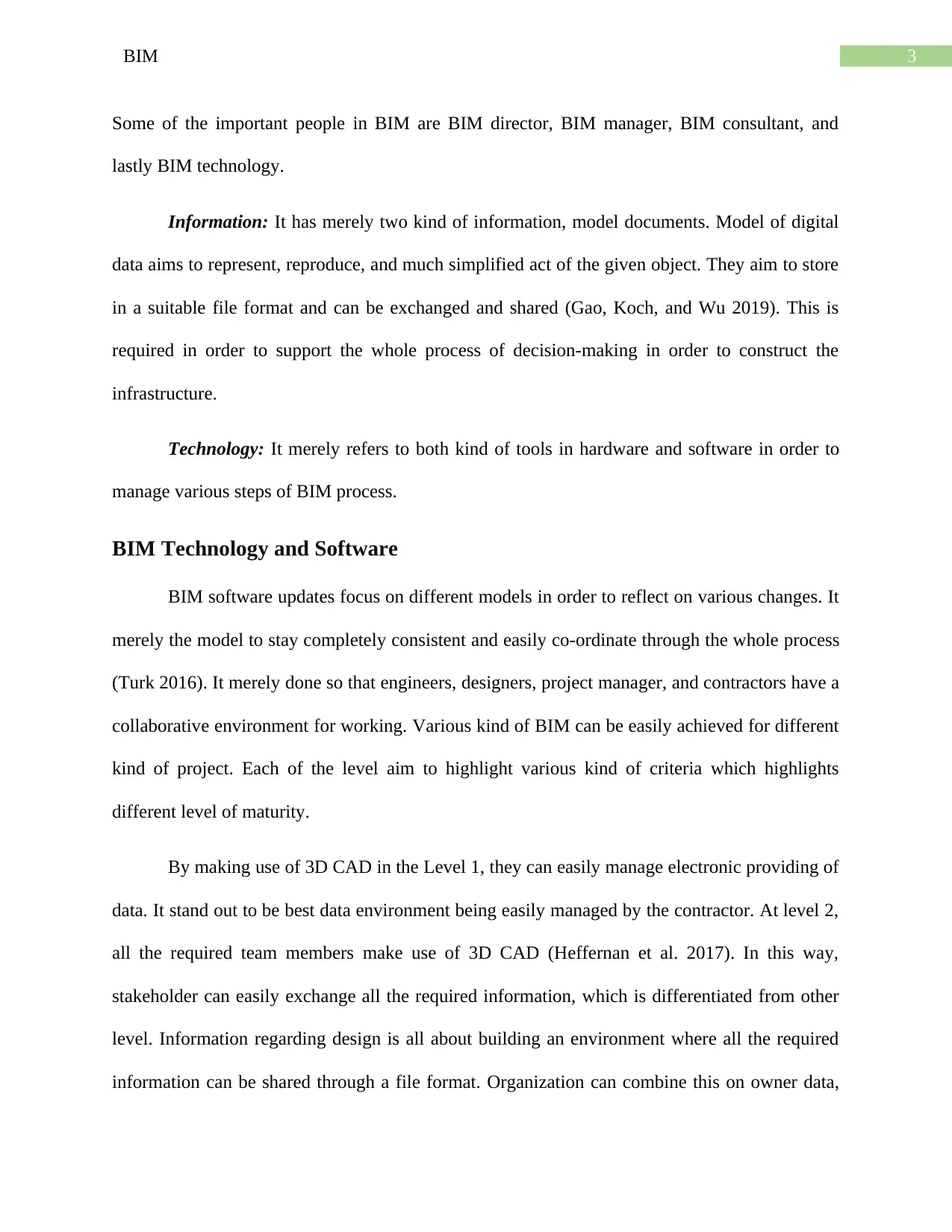
3BIM
Some of the important people in BIM are BIM director, BIM manager, BIM consultant, and
lastly BIM technology.
Information: It has merely two kind of information, model documents. Model of digital
data aims to represent, reproduce, and much simplified act of the given object. They aim to store
in a suitable file format and can be exchanged and shared (Gao, Koch, and Wu 2019). This is
required in order to support the whole process of decision-making in order to construct the
infrastructure.
Technology: It merely refers to both kind of tools in hardware and software in order to
manage various steps of BIM process.
BIM Technology and Software
BIM software updates focus on different models in order to reflect on various changes. It
merely the model to stay completely consistent and easily co-ordinate through the whole process
(Turk 2016). It merely done so that engineers, designers, project manager, and contractors have a
collaborative environment for working. Various kind of BIM can be easily achieved for different
kind of project. Each of the level aim to highlight various kind of criteria which highlights
different level of maturity.
By making use of 3D CAD in the Level 1, they can easily manage electronic providing of
data. It stand out to be best data environment being easily managed by the contractor. At level 2,
all the required team members make use of 3D CAD (Heffernan et al. 2017). In this way,
stakeholder can easily exchange all the required information, which is differentiated from other
level. Information regarding design is all about building an environment where all the required
information can be shared through a file format. Organization can combine this on owner data,
Some of the important people in BIM are BIM director, BIM manager, BIM consultant, and
lastly BIM technology.
Information: It has merely two kind of information, model documents. Model of digital
data aims to represent, reproduce, and much simplified act of the given object. They aim to store
in a suitable file format and can be exchanged and shared (Gao, Koch, and Wu 2019). This is
required in order to support the whole process of decision-making in order to construct the
infrastructure.
Technology: It merely refers to both kind of tools in hardware and software in order to
manage various steps of BIM process.
BIM Technology and Software
BIM software updates focus on different models in order to reflect on various changes. It
merely the model to stay completely consistent and easily co-ordinate through the whole process
(Turk 2016). It merely done so that engineers, designers, project manager, and contractors have a
collaborative environment for working. Various kind of BIM can be easily achieved for different
kind of project. Each of the level aim to highlight various kind of criteria which highlights
different level of maturity.
By making use of 3D CAD in the Level 1, they can easily manage electronic providing of
data. It stand out to be best data environment being easily managed by the contractor. At level 2,
all the required team members make use of 3D CAD (Heffernan et al. 2017). In this way,
stakeholder can easily exchange all the required information, which is differentiated from other
level. Information regarding design is all about building an environment where all the required
information can be shared through a file format. Organization can combine this on owner data,
Paraphrase This Document
Need a fresh take? Get an instant paraphrase of this document with our AI Paraphraser
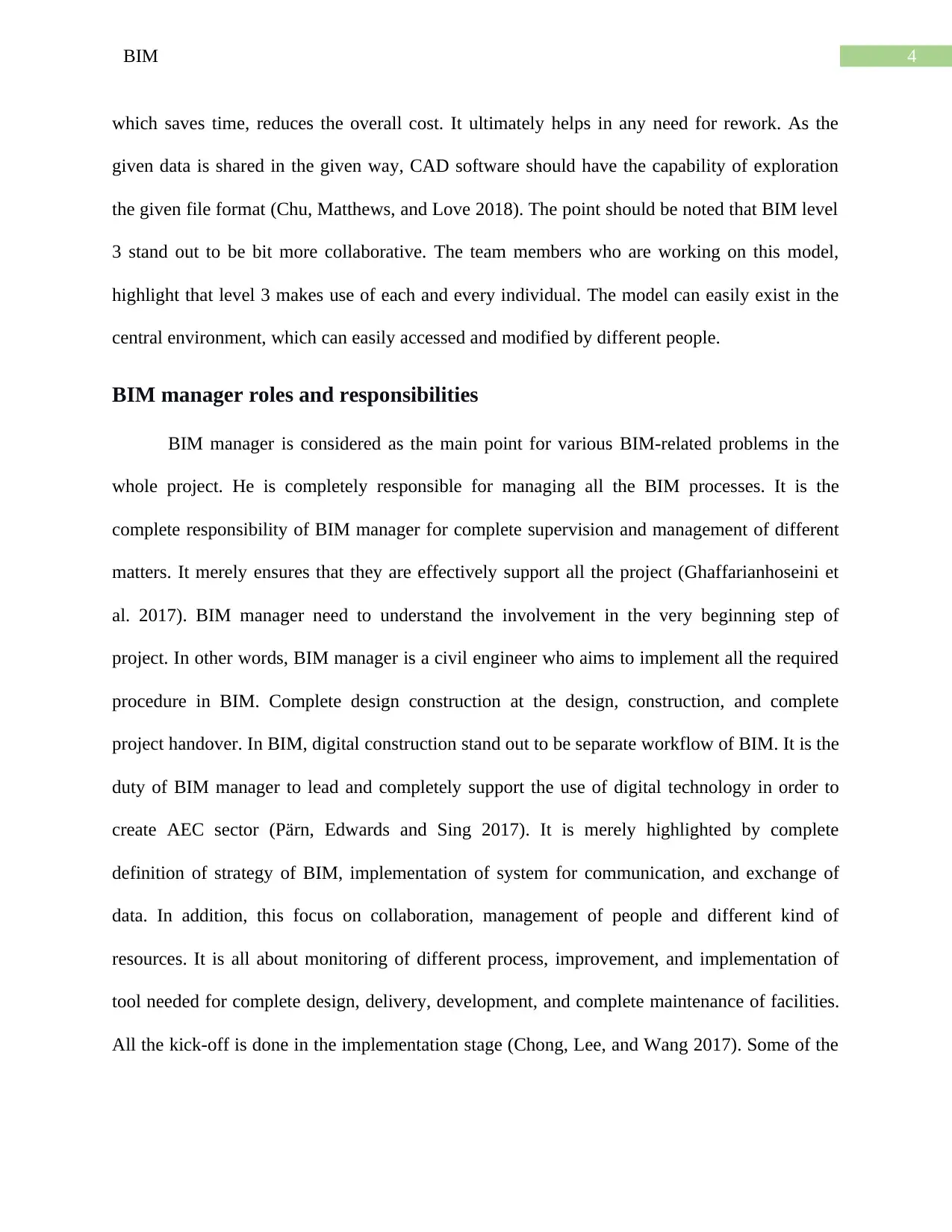
4BIM
which saves time, reduces the overall cost. It ultimately helps in any need for rework. As the
given data is shared in the given way, CAD software should have the capability of exploration
the given file format (Chu, Matthews, and Love 2018). The point should be noted that BIM level
3 stand out to be bit more collaborative. The team members who are working on this model,
highlight that level 3 makes use of each and every individual. The model can easily exist in the
central environment, which can easily accessed and modified by different people.
BIM manager roles and responsibilities
BIM manager is considered as the main point for various BIM-related problems in the
whole project. He is completely responsible for managing all the BIM processes. It is the
complete responsibility of BIM manager for complete supervision and management of different
matters. It merely ensures that they are effectively support all the project (Ghaffarianhoseini et
al. 2017). BIM manager need to understand the involvement in the very beginning step of
project. In other words, BIM manager is a civil engineer who aims to implement all the required
procedure in BIM. Complete design construction at the design, construction, and complete
project handover. In BIM, digital construction stand out to be separate workflow of BIM. It is the
duty of BIM manager to lead and completely support the use of digital technology in order to
create AEC sector (Pärn, Edwards and Sing 2017). It is merely highlighted by complete
definition of strategy of BIM, implementation of system for communication, and exchange of
data. In addition, this focus on collaboration, management of people and different kind of
resources. It is all about monitoring of different process, improvement, and implementation of
tool needed for complete design, delivery, development, and complete maintenance of facilities.
All the kick-off is done in the implementation stage (Chong, Lee, and Wang 2017). Some of the
which saves time, reduces the overall cost. It ultimately helps in any need for rework. As the
given data is shared in the given way, CAD software should have the capability of exploration
the given file format (Chu, Matthews, and Love 2018). The point should be noted that BIM level
3 stand out to be bit more collaborative. The team members who are working on this model,
highlight that level 3 makes use of each and every individual. The model can easily exist in the
central environment, which can easily accessed and modified by different people.
BIM manager roles and responsibilities
BIM manager is considered as the main point for various BIM-related problems in the
whole project. He is completely responsible for managing all the BIM processes. It is the
complete responsibility of BIM manager for complete supervision and management of different
matters. It merely ensures that they are effectively support all the project (Ghaffarianhoseini et
al. 2017). BIM manager need to understand the involvement in the very beginning step of
project. In other words, BIM manager is a civil engineer who aims to implement all the required
procedure in BIM. Complete design construction at the design, construction, and complete
project handover. In BIM, digital construction stand out to be separate workflow of BIM. It is the
duty of BIM manager to lead and completely support the use of digital technology in order to
create AEC sector (Pärn, Edwards and Sing 2017). It is merely highlighted by complete
definition of strategy of BIM, implementation of system for communication, and exchange of
data. In addition, this focus on collaboration, management of people and different kind of
resources. It is all about monitoring of different process, improvement, and implementation of
tool needed for complete design, delivery, development, and complete maintenance of facilities.
All the kick-off is done in the implementation stage (Chong, Lee, and Wang 2017). Some of the
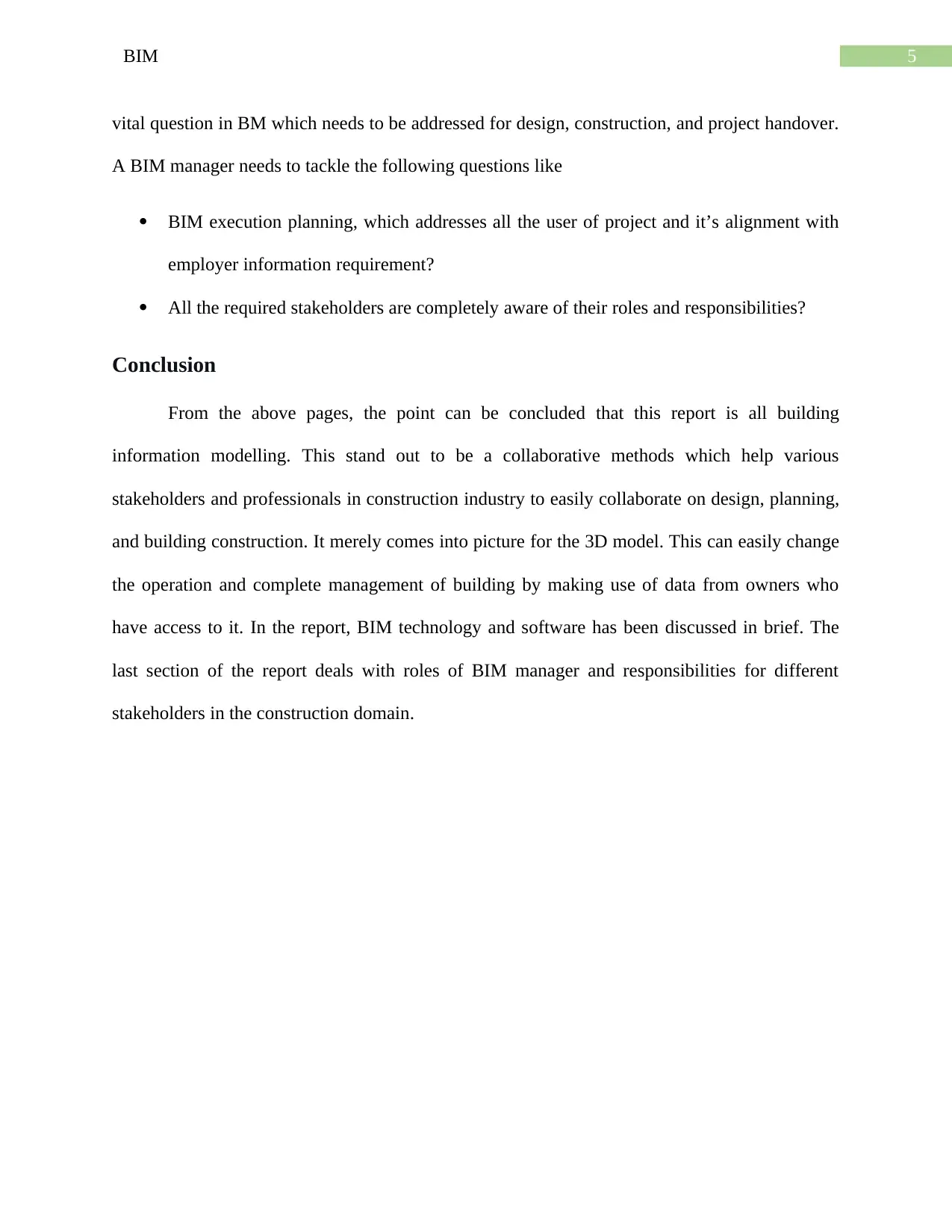
5BIM
vital question in BM which needs to be addressed for design, construction, and project handover.
A BIM manager needs to tackle the following questions like
BIM execution planning, which addresses all the user of project and it’s alignment with
employer information requirement?
All the required stakeholders are completely aware of their roles and responsibilities?
Conclusion
From the above pages, the point can be concluded that this report is all building
information modelling. This stand out to be a collaborative methods which help various
stakeholders and professionals in construction industry to easily collaborate on design, planning,
and building construction. It merely comes into picture for the 3D model. This can easily change
the operation and complete management of building by making use of data from owners who
have access to it. In the report, BIM technology and software has been discussed in brief. The
last section of the report deals with roles of BIM manager and responsibilities for different
stakeholders in the construction domain.
vital question in BM which needs to be addressed for design, construction, and project handover.
A BIM manager needs to tackle the following questions like
BIM execution planning, which addresses all the user of project and it’s alignment with
employer information requirement?
All the required stakeholders are completely aware of their roles and responsibilities?
Conclusion
From the above pages, the point can be concluded that this report is all building
information modelling. This stand out to be a collaborative methods which help various
stakeholders and professionals in construction industry to easily collaborate on design, planning,
and building construction. It merely comes into picture for the 3D model. This can easily change
the operation and complete management of building by making use of data from owners who
have access to it. In the report, BIM technology and software has been discussed in brief. The
last section of the report deals with roles of BIM manager and responsibilities for different
stakeholders in the construction domain.
⊘ This is a preview!⊘
Do you want full access?
Subscribe today to unlock all pages.

Trusted by 1+ million students worldwide
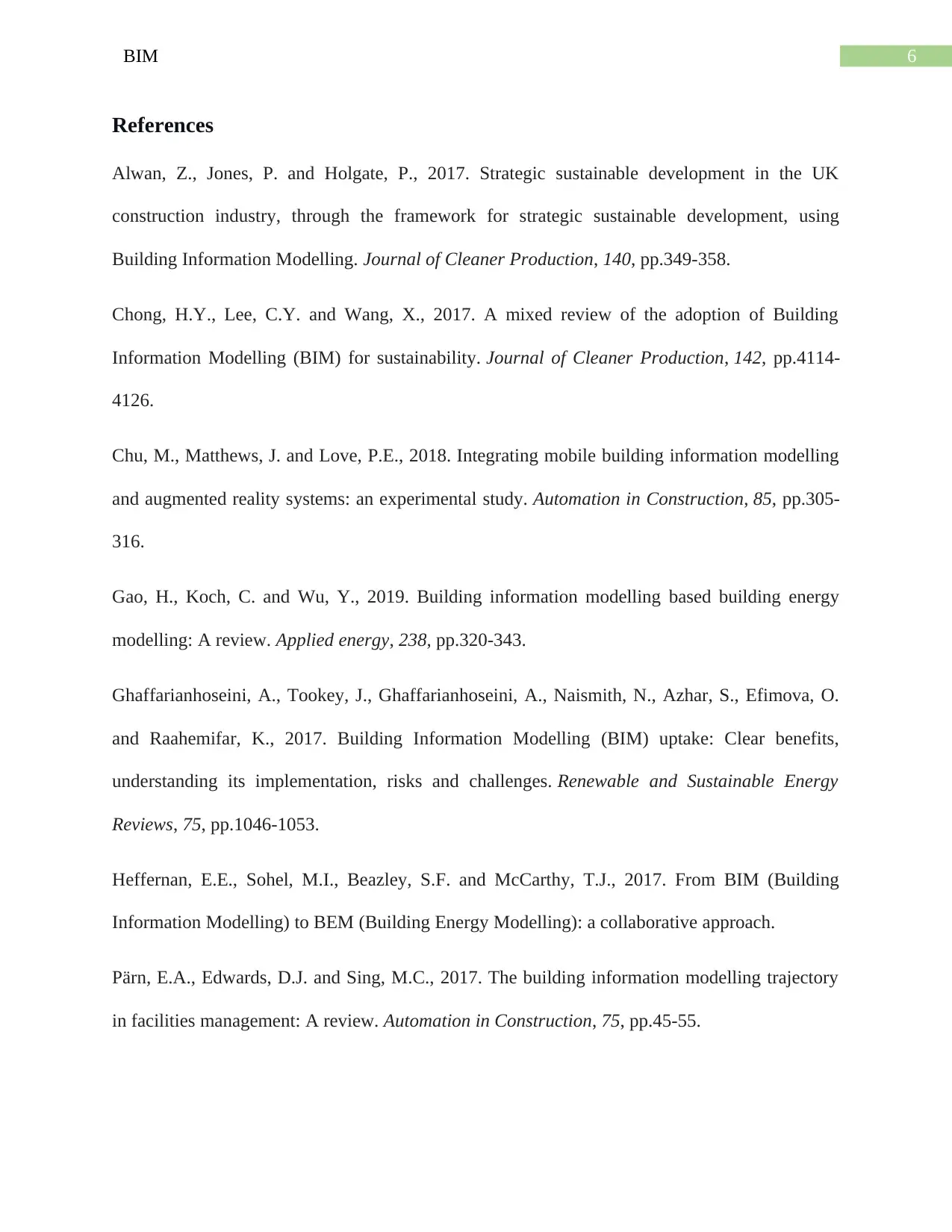
6BIM
References
Alwan, Z., Jones, P. and Holgate, P., 2017. Strategic sustainable development in the UK
construction industry, through the framework for strategic sustainable development, using
Building Information Modelling. Journal of Cleaner Production, 140, pp.349-358.
Chong, H.Y., Lee, C.Y. and Wang, X., 2017. A mixed review of the adoption of Building
Information Modelling (BIM) for sustainability. Journal of Cleaner Production, 142, pp.4114-
4126.
Chu, M., Matthews, J. and Love, P.E., 2018. Integrating mobile building information modelling
and augmented reality systems: an experimental study. Automation in Construction, 85, pp.305-
316.
Gao, H., Koch, C. and Wu, Y., 2019. Building information modelling based building energy
modelling: A review. Applied energy, 238, pp.320-343.
Ghaffarianhoseini, A., Tookey, J., Ghaffarianhoseini, A., Naismith, N., Azhar, S., Efimova, O.
and Raahemifar, K., 2017. Building Information Modelling (BIM) uptake: Clear benefits,
understanding its implementation, risks and challenges. Renewable and Sustainable Energy
Reviews, 75, pp.1046-1053.
Heffernan, E.E., Sohel, M.I., Beazley, S.F. and McCarthy, T.J., 2017. From BIM (Building
Information Modelling) to BEM (Building Energy Modelling): a collaborative approach.
Pärn, E.A., Edwards, D.J. and Sing, M.C., 2017. The building information modelling trajectory
in facilities management: A review. Automation in Construction, 75, pp.45-55.
References
Alwan, Z., Jones, P. and Holgate, P., 2017. Strategic sustainable development in the UK
construction industry, through the framework for strategic sustainable development, using
Building Information Modelling. Journal of Cleaner Production, 140, pp.349-358.
Chong, H.Y., Lee, C.Y. and Wang, X., 2017. A mixed review of the adoption of Building
Information Modelling (BIM) for sustainability. Journal of Cleaner Production, 142, pp.4114-
4126.
Chu, M., Matthews, J. and Love, P.E., 2018. Integrating mobile building information modelling
and augmented reality systems: an experimental study. Automation in Construction, 85, pp.305-
316.
Gao, H., Koch, C. and Wu, Y., 2019. Building information modelling based building energy
modelling: A review. Applied energy, 238, pp.320-343.
Ghaffarianhoseini, A., Tookey, J., Ghaffarianhoseini, A., Naismith, N., Azhar, S., Efimova, O.
and Raahemifar, K., 2017. Building Information Modelling (BIM) uptake: Clear benefits,
understanding its implementation, risks and challenges. Renewable and Sustainable Energy
Reviews, 75, pp.1046-1053.
Heffernan, E.E., Sohel, M.I., Beazley, S.F. and McCarthy, T.J., 2017. From BIM (Building
Information Modelling) to BEM (Building Energy Modelling): a collaborative approach.
Pärn, E.A., Edwards, D.J. and Sing, M.C., 2017. The building information modelling trajectory
in facilities management: A review. Automation in Construction, 75, pp.45-55.
Paraphrase This Document
Need a fresh take? Get an instant paraphrase of this document with our AI Paraphraser

7BIM
Turk, Ž., 2016. Ten questions concerning building information modelling. Building and
Environment, 107, pp.274-284.
Turk, Ž., 2016. Ten questions concerning building information modelling. Building and
Environment, 107, pp.274-284.
1 out of 8
Related Documents
Your All-in-One AI-Powered Toolkit for Academic Success.
+13062052269
info@desklib.com
Available 24*7 on WhatsApp / Email
![[object Object]](/_next/static/media/star-bottom.7253800d.svg)
Unlock your academic potential
Copyright © 2020–2025 A2Z Services. All Rights Reserved. Developed and managed by ZUCOL.




